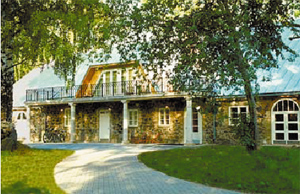To the Manor Returned

An Estonian island local comes home to turn a dilapidated property into a chic hotel.
By Benjamin Smith
It is early april on Muhu island. Here, off the coast of Estonia, the snow has just melted, and newly arrived geese are honking on the nearby bay. The setting sun frames Imre Sooäär – dressed in crisp blue jeans and a black leather jacket – against the plain white façade of a historic 25-room manor house.
 Sooäär and Martin Breuer, his rumpled Dutch partner, stand on a balcony above the building’s grand entrance, looking out on the resort they’ve spent the past five years creating. It includes five lovingly preserved stone buildings and a large courtyard between the manor house and the quiet strait of the Baltic Sea. ’It has a life of its own,“ Sooäär says, taking in the view. ’Pädaste is living its own story.“
Sooäär and Martin Breuer, his rumpled Dutch partner, stand on a balcony above the building’s grand entrance, looking out on the resort they’ve spent the past five years creating. It includes five lovingly preserved stone buildings and a large courtyard between the manor house and the quiet strait of the Baltic Sea. ’It has a life of its own,“ Sooäär says, taking in the view. ’Pädaste is living its own story.“
The faded maps that line the walls of a low stone guest house tell the story not only of Pädaste Manor but also of this island, which was one of the last holdouts of paganism in Europe. Early in the 14th century the Teutonic Knights, a Germanic order of soldier-priests, were campaigning through the Baltics to Christianize the local people. By 1346 the knights had conquered what is now Lithuania, Latvia, and Estonia.
A leader of the invaders, Albert von Buxhoeveden, took a liking to Muhu, one of the 800 or so islands in the archipelago. After conquering the last of the pagans, he made the island his estate, building a luxurious Baltic holding on the island’s quiet southeastern corner. The family summered on Muhu and wintered in St. Petersburg, as did other courtiers and generals of the era.
The manor house had been slowly deteriorating since World War I, when local Communists briefly seized power and put an icy end to the von Buxhoevedens and their luxurious lifestyle: In early 1919 the Communists drowned the baron, his brother, and their prize horses beneath the frozen Baltic.
The Soviets eventually turned the manor into a nursing home. Pensioners occupied the mansion, while the outbuildings served as winter quarters for pigs or chickens. As a child, Sooäär played amid the decaying buildings, which in 1984 were condemned and evacuated.
Five years later Sooäär, then a red-cheeked farm boy, left Muhu, escaping the long, cold winters spent minding the cattle, the Sisyphean summers spent working the stony fields, and the rest of the life that had kept his family on the tiny island for five centuries.
In Sooäär’s case, there was also a more pressing reason to leave. The Soviet Union still ruled Estonia, maintaining secret missile silos in the center of Muhu, and Sooäär had just been drafted for a three-year stint in the navy. Desperate for a way out, the 19-year-old wrangled a visit to relatives in Canada and went awol.
’I thought I was leaving forever,“ says the man who now lives a few minutes from his parents’ stone farmhouse.
On a cold January day in 1996, Sooäär’s mother, Ina, called from Muhu with news that Pädaste Manor was to be privatized within the week, probably sold to a local politician. Sooäär, who was in Toronto running a small commercial film studio, boarded the next Finnair flight.
’We wrote up a business plan in a day,“ he recalls. The two men put down $30,000 on the property, Sooäär sold his share in the film company to his business partner, Breuer sold his portion of a 400-employee retail business to his brother, and they moved to Muhu.
’My friends thought I was crazy,“ Breuer told me over a breakfast of local produce and the region’s typical grainy dark bread. But the Dutchman had always dreamed of running a hotel, and he worried that he would miss his chance.
Sooäär says he realized that this was his ’opportunity to leave a little mark on the world, or a signature on something that will be here after I’m gone.“
The resort currently occupies three of the estate’s five outbuildings – the former stable, smithy, and cheese factory. The walls of the buildings are made of basketball-size red and black stones, and local dolomite frames the windows in white. Nearby, the big manor house, with its aged facade, retains its noble look, but the dilapidated interior is a work in progress.
When Sooäär first returned there were trees growing through the mansion’s windows and discarded scrap metal on the lawn, he tells me as we savor bowls of Thai chicken soup while seated in front of a wide fireplace.
’This room was full up to here with dense layers of cultural heritage,“ says Sooäär, holding his hand flat over the table, ’all mixed with horse dung.“ Now the hotel’s seaside restaurant, which occupies the former smithy, is decorated with anchors and other nautical elements from the island. It serves such dishes as spanakopita with yogurt sauce, as well as Baltic salmon partnered with locally grown potatoes.
Working slowly and carefully, Sooäär and Breuer turned the cheese factory into a four-room guest house with a kitchen, a sauna, and a terrace facing the sea. As they began to make a profit from hosting guests, they restored the carriage house and stables next door, adding five more double rooms, and – at Sooäär’s insistence – an eight-seat movie theater complete with reclining chairs, a wide selection of DVDs, and a state-of-the-art sound system.
The nine rooms are cozy and warm; each of the five split-level doubles in the carriage house has rich red carpets and is furnished with a simple dark- wood armoire, a bureau, and a secretary. A white sofa and a wood table sit beside glass doors that open onto a balcony with a view of the sea. Atop the bureau sits a shiny new compact stereo system (playing a CD by an avant garde Estonian choral composer).
These days Estonia’s bankers, politicians, and entertainers stay at Pädaste, which has become the fashionable resort of choice for the young Estonian elite. The prime minister and president have visited, and despite the fact that Pädaste has never advertised, by April its nine rooms were booked for most of the short, luxuriant Estonian summer. The island’s rocky coasts, its low juniper bushes, and quietude charm visitors.
Sooäär says he has fended off several offers to buy him out. He wants to complete the job of restoring the big manor house to its former splendor, and add 16 more rooms. After that, he says, he may give filmmaking another try. But for now he’s content to be a man of the manor.
’Pädaste is like a diamond,“ he says, ’we have found it, and we can cut it as we want.“
Benjamin Smith is a Wall Street Journal correspondent based in Latvia.
Copyright © Islands Magazine






